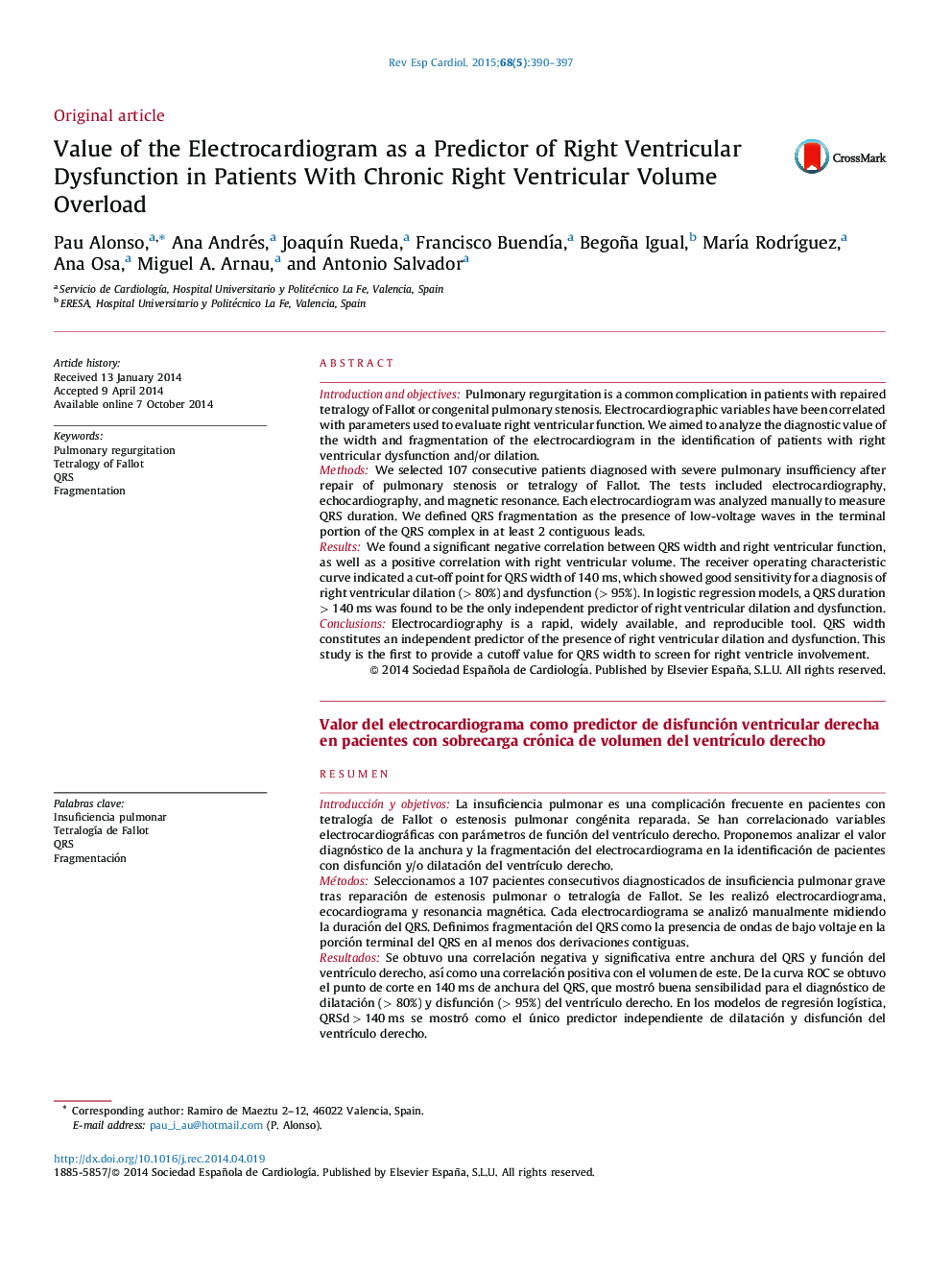| کد مقاله | کد نشریه | سال انتشار | مقاله انگلیسی | نسخه تمام متن |
|---|---|---|---|---|
| 3016158 | 1182073 | 2015 | 8 صفحه PDF | دانلود رایگان |
Introduction and objectivesPulmonary regurgitation is a common complication in patients with repaired tetralogy of Fallot or congenital pulmonary stenosis. Electrocardiographic variables have been correlated with parameters used to evaluate right ventricular function. We aimed to analyze the diagnostic value of the width and fragmentation of the electrocardiogram in the identification of patients with right ventricular dysfunction and/or dilation.MethodsWe selected 107 consecutive patients diagnosed with severe pulmonary insufficiency after repair of pulmonary stenosis or tetralogy of Fallot. The tests included electrocardiography, echocardiography, and magnetic resonance. Each electrocardiogram was analyzed manually to measure QRS duration. We defined QRS fragmentation as the presence of low-voltage waves in the terminal portion of the QRS complex in at least 2 contiguous leads.ResultsWe found a significant negative correlation between QRS width and right ventricular function, as well as a positive correlation with right ventricular volume. The receiver operating characteristic curve indicated a cut-off point for QRS width of 140 ms, which showed good sensitivity for a diagnosis of right ventricular dilation (> 80%) and dysfunction (> 95%). In logistic regression models, a QRS duration > 140 ms was found to be the only independent predictor of right ventricular dilation and dysfunction.ConclusionsElectrocardiography is a rapid, widely available, and reproducible tool. QRS width constitutes an independent predictor of the presence of right ventricular dilation and dysfunction. This study is the first to provide a cutoff value for QRS width to screen for right ventricle involvement.
ResumenIntroducción y objetivosLa insuficiencia pulmonar es una complicación frecuente en pacientes con tetralogía de Fallot o estenosis pulmonar congénita reparada. Se han correlacionado variables electrocardiográficas con parámetros de función del ventrículo derecho. Proponemos analizar el valor diagnóstico de la anchura y la fragmentación del electrocardiograma en la identificación de pacientes con disfunción y/o dilatación del ventrículo derecho.MétodosSeleccionamos a 107 pacientes consecutivos diagnosticados de insuficiencia pulmonar grave tras reparación de estenosis pulmonar o tetralogía de Fallot. Se les realizó electrocardiograma, ecocardiograma y resonancia magnética. Cada electrocardiograma se analizó manualmente midiendo la duración del QRS. Definimos fragmentación del QRS como la presencia de ondas de bajo voltaje en la porción terminal del QRS en al menos dos derivaciones contiguas.ResultadosSe obtuvo una correlación negativa y significativa entre anchura del QRS y función del ventrículo derecho, así como una correlación positiva con el volumen de este. De la curva ROC se obtuvo el punto de corte en 140 ms de anchura del QRS, que mostró buena sensibilidad para el diagnóstico de dilatación (> 80%) y disfunción (> 95%) del ventrículo derecho. En los modelos de regresión logística, QRSd > 140 ms se mostró como el único predictor independiente de dilatación y disfunción del ventrículo derecho.ConclusionesEl electrocardiograma es una herramienta rápida, disponible y reproducible. La anchura del QRS permite predecir de manera independiente la presencia de dilatación y disfunción del ventrículo derecho. Este es el primer estudio que propone un punto de corte en la anchura del QRS para el cribado de afección del ventrículo derecho.
Journal: Revista Española de Cardiología (English Edition) - Volume 68, Issue 5, May 2015, Pages 390–397
